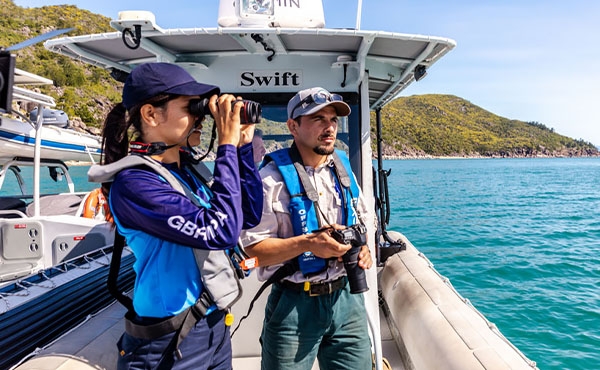Activities undertaken by the Australian Department of Defence in the Region continue to be managed effectively, reflecting the maturity of the Defence management system and relationship between Defence and the Reef Authority.
The Department of Defence manages defence activities in the Region with input from other government agencies. For major exercises involving allied forces, such as Talisman Sabre, they collaborate with agencies including the Reef Authority, the Queensland Department of Environment, Science and Innovation (through the Queensland Parks and Wildlife Service) and the Australian Department of Climate Change Energy, the Environment and Water. Traditional Owners and Indigenous Land Use Agreement holders, as well as regional communities for Training Areas such as the Shoalwater Bay Training Area, are also consulted. Defence also oversees areas such as Shoalwater Bay, Cowley Beach and Halifax Training Areas, and HMAS Cairns that are partly within the boundaries of the Region, as well as the Townsville Field Training Area, RAAF Townsville, and the Ross Island and Lavarack Barracks, which are adjacent to the Region.
The Strategic Environmental Assessment of Defence Activities in the Great Barrier Reef World Heritage Area (Strategic Environmental Assessment) provides contextual understanding of the environmental risk of defence activities in the Region.1970 The ongoing management of environmental risks at Defence sites is carried out using an internal planning and management system. This system is mature and includes both a nationwide management framework and domain-specific environmental management plans together with site- and activity-specific instruments. In accordance with the strategic environmental assessment, environmental risks of defence activities in the Region are managed through this national-scale system. There is a Region-specific Great Barrier Reef and Coral Sea Planning Handbook to complement the suite of tools. The management effectiveness grade for planning has decreased, reflecting the uncertainty around implementation of recommendations to improve stakeholder engagement that were identified in a 2014 evaluation.1971
Defence activities are self-regulated albeit subject to environmental commitments under the EPBC Act and other legislation. Department of Defence continues to demonstrate a strong commitment to this self-regulation and adopts best-practice standards. Resourcing and in-house expertise are adequate within Defence to address requirements of environmental management. Defence also has a Memorandum of Understanding with the Reef Authority that provides the managers of the Reef an advisory role to decisions on activities within the Region, bringing an additional level of oversight. In 2023, the memorandum was being updated to include a commitment to revisiting the current strategic environmental assessment, which will provide updated planning considerations for the Region. The management effectiveness grade for inputs has decreased and this is attributed to a recognition of knowledge gaps around offshore Indigenous heritage information available to decision-making.



